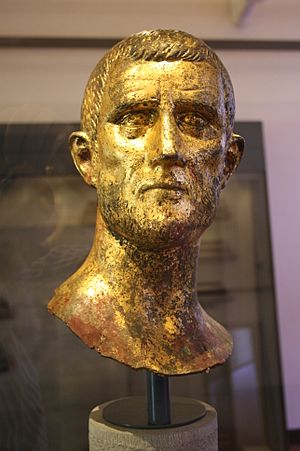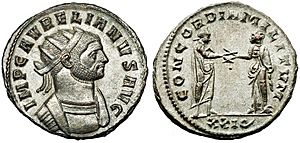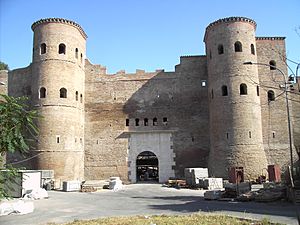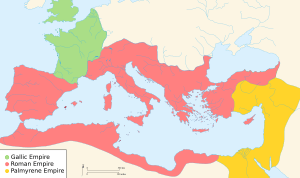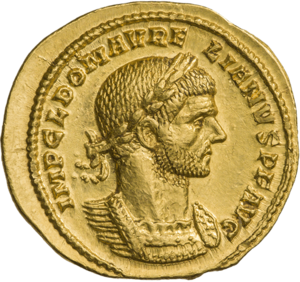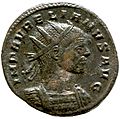Aurelian facts for kids
Quick facts for kids Aurelian |
|||||||||
|---|---|---|---|---|---|---|---|---|---|
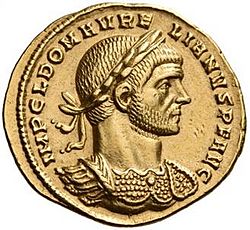
Aureus of Emperor Aurelian with inscription
IMP. C. L. DOM. AVRELIANVS P. F. AVG. |
|||||||||
| Roman emperor | |||||||||
| Reign | c. May 270 – c. October 275 | ||||||||
| Predecessor | Quintillus | ||||||||
| Successor | Tacitus | ||||||||
| Born | 9 September 214 Dacia Ripensis or Sirmium (Pannonia) |
||||||||
| Died | c. October 275 (aged 61) Caenophrurium, Thracia (modern-day Sinekli, Silivri, İstanbul, Turkey) |
||||||||
| Spouse | Ulpia Severina | ||||||||
| Issue | 1 daughter | ||||||||
|
|||||||||
| Religion | Henotheist of Sol Invictus | ||||||||
Aurelian (Latin: Lucius Domitius Aurelianus; 9 September 214 – c. October 275) was a powerful Roman emperor who ruled from 270 to 275 AD. He lived during a very difficult time for the Roman Empire, known as the Crisis of the Third Century. During this period, the empire was almost falling apart due to attacks from outside groups and internal rebellions.
Aurelian was born in a simple family near the Danube River. He joined the Roman army in 235 AD and quickly rose through the ranks. He became a top cavalry leader for Emperor Gallienus. After Gallienus's death in 268, and then Emperor Claudius Gothicus's death in 270, Aurelian became emperor. He won many important military victories, bringing the Roman Empire back together. He defeated groups like the Alamanni, Goths, and Vandals. He also brought back the eastern provinces by conquering the Palmyrene Empire in 273. The next year, he took back the Gallic Empire in the west, making the Roman Empire whole again.
Aurelian also built the Aurelian Walls around Rome to protect it. He decided to give up the province of Dacia because it was too hard to defend. He also made changes to the Roman money system to stop its value from dropping. Because of his great successes, he was given the special title Restitutor Orbis, which means "Restorer of the World."
Contents
Early Life of Aurelian
Aurelian was born on September 9, 214 AD. We know this date from old Roman records. He was likely born in a region called Dacia Ripensis, which was part of Moesia Superior at the time. This area is near the Danube River.
Like many other emperors of his time, Aurelian was from Illyria. These "Illyrian Emperors" often came from military backgrounds. Aurelian's father was probably a farmer who worked on a senator's land. It's also thought that his father was a former Roman soldier. Aurelian's mother was possibly connected to the worship of the sun god Sol, a god Aurelian later promoted as emperor.
Aurelian's Military Career
Aurelian likely joined the army around 235 AD, when he was about 20 years old. He quickly gained a strong reputation for being a very skilled soldier and leader. He became known for his abilities during the many wars and problems of the mid-3rd century.
He was a key officer in Emperor Gallienus's special cavalry unit. Later, under Emperor Claudius II Gothicus, Aurelian became the commander of this important cavalry.
Ulpius Crinitus
Some historical stories mention a general named Ulpius Crinitus. He was said to be a commander of legions in Illyria and Thracia. This general reportedly took an interest in Aurelian's early career.
When Goths invaded Illyria and Thrace, Ulpius Crinitus was sick. He ordered Aurelian to fight the invaders. Aurelian, leading 2,500 auxiliary troops and armies from four Germanic chiefs, defeated the Goths. After this victory, Crinitus supposedly adopted Aurelian as his heir. A painting showing Ulpius Crinitus and Aurelian was found in the Temple of Sol Invictus, which supports the idea that he existed.
Serving Emperors Gallienus and Claudius
Aurelian's success as a cavalry commander led him to join Emperor Gallienus's close group. In 268 AD, Gallienus was fighting a rebel general named Aureolus. Aurelian was present when Gallienus was assassinated during this siege. Some sources suggest Aurelian supported General Claudius to become the next emperor.
In 268 or 269 AD, Aurelian and his cavalry helped Emperor Gallienus (or Claudius II Gothicus) win a big victory against the Goths at the Battle of Naissus.
Aurelian was married to Ulpia Severina, who was from Dacia. They had one daughter together.
Under Emperor Claudius, Aurelian was quickly promoted. He was given command of the elite Dalmatian cavalry. Soon after, he became the overall head of the army.
While Claudius was dealing with a rebellion, the Alamanni broke through the Roman borders near the Danube. They entered northern Italy and started looting. In early 269 AD, Emperor Claudius and Aurelian marched north and defeated the Alamanni at the Battle of Lake Benacus.
Soon after, news came of large attacks from other groups like the Heruli and Goths in the Balkans. Claudius sent Aurelian to stop the invasion until the main army could arrive. Aurelian's cavalry fought the Goths in many small battles, killing thousands. He kept pushing them north, where Emperor Claudius's main army was waiting.
The Goths were eventually trapped and surrounded in the Haemus Mountains during winter. They were running out of food. Although the Romans let their guard down, the Goths managed to break through. Aurelian's cavalry had to charge in to stop them from causing more damage.
The Roman army continued to chase the Goths through 270 AD. A terrible plague also spread, killing many soldiers. Emperor Claudius fell ill and returned to his headquarters, leaving Aurelian in charge. Aurelian used his cavalry to break the Goths into smaller groups, finally defeating them by late summer. Survivors were either forced into the army or settled as farmers.
Just as Aurelian finished his victories, news arrived that Emperor Claudius had died in August 270 AD.
Aurelian Becomes Emperor
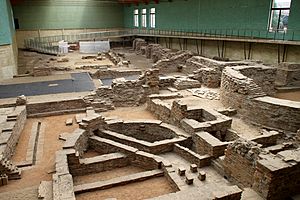
After Claudius died, his brother Quintillus took power with the support of the Senate. However, the army refused to accept Quintillus. Instead, they chose Aurelian as emperor in May 270 AD in Sirmium. Aurelian defeated Quintillus's troops, and after Quintillus's death, the Senate recognized Aurelian as the new emperor.
With his power secure, Aurelian focused on the empire's biggest problems. He needed to get back the huge territories that had been lost over the past 20 years and fix the Roman government.
The Roman Empire in the 270s
The Roman Empire had been very strong, but by the 270s, it faced huge challenges. Enemies from outside were attacking, and civil wars inside the empire weakened it. The economy, including farming and trade, suffered greatly. A terrible plague around 250 AD also reduced the number of people available for the army and for work.
In 260 AD, Emperor Valerian was captured by the Sassanids. This was a huge blow. In the east, the city of Palmyra in Syria became very powerful and formed its own Palmyrene Empire. In the west, provinces along the Rhine River broke away to form the Gallic Empire. This meant the Roman Empire was split into three parts.
The emperor in Rome was busy dealing with threats to his power and defending Italy and the Balkans.
Reuniting the Empire
Aurelian's first actions as emperor were to make his position stronger. In late 270 AD, he fought against the Vandals, Juthungi, and Sarmatians in northern Italy, driving them out. To celebrate these wins, he was given the title Germanicus Maximus.
Several rebels tried to take power from Aurelian, but he was an experienced commander and knew how important the army's support was. His coins showed messages that aimed to get the legions' loyalty.
Defending Italy from the Juthungi
In 271 AD, the Alamanni invaded Italy. They entered the Po plain, looted villages, and moved towards Fano. Aurelian quickly returned to Italy, but his army was defeated in an ambush near Placentia.
News of this defeat caused great fear in Rome. But Aurelian quickly attacked the Alamanni near the Metaurus River, defeating them at the Battle of Fano. He then completely routed them at Pavia. For this, he again received the title Germanicus Maximus. Because the threat of Germanic invasions was still high, Aurelian decided to build new, stronger walls around Rome. These are known as the Aurelian Walls.
Defeating the Goths and Leaving Dacia
Aurelian then led his legions to the Balkans. He defeated the Goths and drove them back across the Danube River. He killed their leader, Cannabaudes, and earned the title Gothicus Maximus.
However, Aurelian decided to abandon the province of Dacia. It was on the north bank of the Danube and was too difficult and expensive to defend. He created a new province called Dacia Aureliana south of the Danube, with Serdica as its capital.
Taking Back the Palmyrene Empire
In 272 AD, Aurelian focused on the eastern parts of the empire that had been lost to the Palmyrene Empire. This empire was ruled by Queen Zenobia from the city of Palmyra. Zenobia had taken control of Syria, Palestine, Egypt, and large parts of Asia Minor. She even cut off Rome's grain supply, causing food shortages.
Aurelian decided to invade. He easily took back Asia Minor, as most cities surrendered without much fighting. Only Byzantium and Tyana resisted. The fall of Tyana became famous: Aurelian had planned to destroy the city, but he had a dream about the philosopher Apollonius of Tyana. Apollonius told him to be merciful if he wanted to rule and conquer. Aurelian spared Tyana, and this decision paid off. Many other cities then surrendered, seeing that the emperor would not punish them.
Within six months, Aurelian's armies reached Palmyra. The city surrendered when Queen Zenobia tried to escape to the Sassanid Empire.
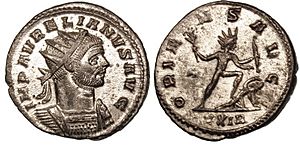
Zenobia and her son were captured and later paraded through the streets of Rome in Aurelian's victory parade, with Zenobia in golden chains. With the grain supply restored, Aurelian's soldiers gave out free bread in Rome, and the emperor was seen as a hero.
After a brief fight with the Persians and another in Egypt, Aurelian had to return to Palmyra in 273 AD because the city rebelled again. This time, Aurelian allowed his soldiers to loot the city, and Palmyra never fully recovered. Aurelian received more honors, including Parthicus Maximus and Restitutor Orientis ("Restorer of the East").
The rich province of Egypt was also recovered. The Brucheion (Royal Quarter) in Alexandria was burned down. This area once held the Library of Alexandria, though it's unclear how much of the library was still there in Aurelian's time.
Taking Back the Gallic Empire
In 274 AD, Aurelian turned his attention to the west and the Gallic Empire. This empire had already been made smaller by Claudius II. Aurelian won this campaign mostly through clever talks. The "Gallic Emperor" Tetricus wanted to give up his throne and let Gaul and Britain return to the Roman Empire. However, he couldn't just surrender openly.
So, it seems they planned together. When their armies met at the Battle of Châlons that autumn, Tetricus simply left his army and went to the Roman camp. Aurelian then easily defeated the Gallic army. Tetricus was rewarded for his help. Aurelian made him a senator and a governor in Italy.
Aurelian returned to Rome and received his final honor from the Senate: Restitutor Orbis ("Restorer of the World"). He had first used this title in 272 AD. In just four years, Aurelian had secured the empire's borders and brought it back together.
Aurelian's Reforms
Aurelian was a reformer who made many important changes to how the empire worked, especially concerning the economy and religion. He repaired many public buildings, improved how food was managed, set fair prices for important goods, and punished corrupt officials.
Religious Changes
Aurelian made the Sun god Sol Invictus the most important god in the Roman religion. He wanted all people in the empire, whether civilians or soldiers, from the east or west, to have one main god they could believe in without giving up their own gods. The main place of worship for Sol Invictus was a new temple built in 274 AD in Rome. It was decorated with riches taken from the Palmyrene Empire.
During his short rule, Aurelian seemed to believe in "one faith, one empire." He even used the title deus et dominus natus ("God and born ruler") on some of his coins. Some Christian historians say he organized persecutions against Christians.
Coinage Reform and Rebellion
Aurelian's reign saw the only uprising of mint workers in Roman history. A financial official named Felicissimus, who oversaw the mint in Rome, rebelled against Aurelian. It seems that mint workers, including Felicissimus, were stealing silver and making coins of poor quality. Aurelian wanted to stop this and put Felicissimus on trial.
Felicissimus encouraged the mint workers to rebel. The rebellion spread through the streets, though Felicissimus himself was likely killed quickly. The rebellion also had support from some senators who had supported the previous emperor, Quintillus.
Aurelian ordered his city troops, along with some regular army soldiers, to attack the rebels. The battle, fought on the Caelian hill, ended the revolt, but at a high cost. Many rebels were executed, and some supporting senators were also put to death. The mint in Rome was temporarily closed.
Aurelian's money reform included introducing new coins called antoniniani that contained 5% silver. They had a mark that meant 20 of these coins had the same amount of silver as an old silver denarius. This shows how bad the economic situation was. Aurelian tried to introduce these new "good" coins by recalling all the old "bad" ones first.
Food Distribution Changes
Rome had been giving grain to its poorest citizens at a low price, and later for free, for a long time. Aurelian is known for changing this system. He started giving out bread instead of just grain or flour. He also added olive oil, salt, and pork to the products given to the public. These items had only been given out sometimes before.
Aurelian is also credited with making the loaves of bread bigger without raising their price. This was very popular with the Roman people.
Aurelian's Death
After the Sassanid Kings Shapur I and Hormizd I died quickly, a weaker ruler, Bahram I, came to power. This gave Aurelian a chance to attack the Sassanid Empire. In 275 AD, Aurelian set out for this campaign. On his way, he stopped a revolt in Gaul and defeated barbarian raiders in Vindelicia.
However, Aurelian never reached Persia. He was murdered while waiting in Thracia to cross into Asia Minor. Aurelian was a strict leader and gave harsh punishments to corrupt officials or soldiers. One of his secretaries, named Eros, told a lie about a small matter. Fearing what the emperor might do, he created a fake document listing high officials marked for execution. He showed this to other officers. These officers, fearing punishment from the emperor, murdered Aurelian in late September or early October 275 AD, in Caenophrurium, Thracia.
Aurelian's enemies in the Senate briefly tried to erase his memory from public records, but this was quickly reversed. Aurelian, like his predecessor Claudius II, was later honored as a god, Divus Aurelianus.
There is some idea that Aurelian's wife, Ulpia Severina, who was declared Empress in 274 AD, might have ruled the empire for a short time after his death. Some of her coins seem to have been made after Aurelian died.
Aurelian's Legacy
The city of Orléans in France is named after Aurelian. It was originally called Cenabum, but Aurelian rebuilt it and renamed it Aurelianum or Aureliana Civitas ("city of Aurelian"). This name later became Orléans. The city of New Orleans in the United States is named after Orléans, and therefore, indirectly, after Aurelian.
See also
 In Spanish: Aureliano para niños
In Spanish: Aureliano para niños
Images for kids


